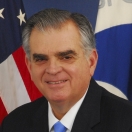
View the full-sized photo gallery.
If you were reading my blog during National Transportation Week last month, you know it was a busy week for the Department of Transportation and for me. In Tennessee, Nevada, and California, I saw innovative projects that will make Americans safer, create good jobs for U.S. workers, and help people get where they need to go without suffering at the gas pump.
In Smyrna, Tennessee, I toured the construction site for Nissan's $1.7 billion electric vehicle battery plant, made possible, in part, by a loan from the US Department of Energy. Nissan is building the new plant right next to an existing plant that is being converted to produce as many as 150,000 new Leaf electric vehicles a year. Together, we expect the two facilities to create 1,300 new jobs.
The Leaf--and other electric vehicles-- will give American families a vehicle option that frees them from the pain of refilling their cars with expensive gas. It also emits fewer greenhouse gases for a more environmentally sustainable ride. And, President Obama has proposed to convert the $7,500 tax credit for hybrid and electric vehicles into a tax rebate consumers can get before they even leave the dealership.
Of course, when it comes to sustainability and low-cost transportation nothing beats foot power. And in Yountville, California, I had a chance to take a bicycle ride on the Napa Valley Vine Trail. When this network of multi-use pedestrian and bicycle trails is completed, it will connect the entire Napa Valley from Vallejo Ferry to Calistoga. The 44 miles of linked trails will allow Californians to commute and will also encourage bicycle tourism, which is a great source of revenue for the regional economy.
Also in Napa, I helped break ground on a new glideslope for the Napa County Airport. The new project will allow more planes to land safely at Napa during bad weather instead of having to be rerouted to the Bay Area.
California's capital, Sacramento, has transportation innovation to spare. For example, the Port of West Sacramento is a key onramp to the marine highway connecting West Sacramento, Stockton, and Oakland. America's Marine Highways offer a way of shifting cargo to our inland waterways to ease congestion on area highways and reduce our reliance on imported oil.
Sacramento is also home to the California Fuel Cell Partnership, a collaboration of automakers, energy providers, government agencies, and technology companies working together to help bring hydrogen fuel cell vehicles to market. The Federal Transit Administration has helped local transit agencies purchase a number of hydrogen fuel-cell transit buses, and during my visit I had the opportunity to climb aboard one currently serving residents in the Alameda-Contra Costa area.
Of course, National Transportation Week would not have been complete without discussing one of the most exciting developments in American transportation: President Obama's commitment to connect 80 percent of Americans with high-speed rail in the next 25 years. I had a chance to talk about the benefits of U.S. high-speed rail corridors and the future of travel at the in Global Travel and Tourism Summit in Las Vegas, Nevada. You can bet that travel professionals are looking forward to improved inter-city passenger rail.
In one short but busy week, I had close-up looks at the future of cars, bikes, ports, planes, and transit--with a long conversation about the promise of high-speed rail. I hope it's easy to see why I love my job and why everyone at DOT is excited about the future of American transportation.


